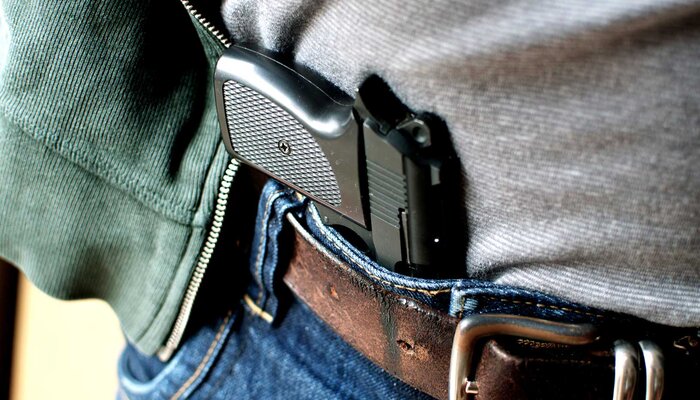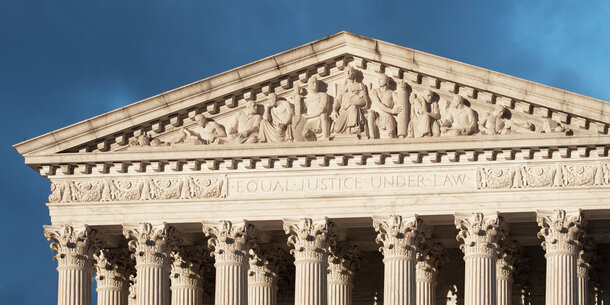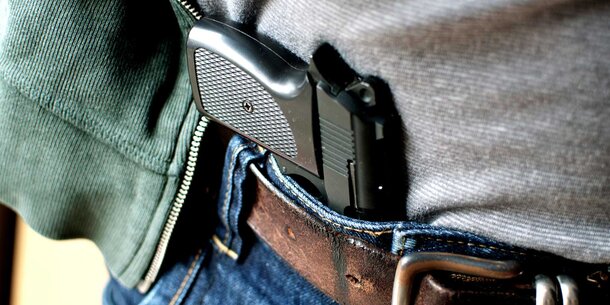UPDATE: On June 23, the Supreme Court blocked the New York law.
In the coming days or months, the Supreme Court will rule on one of the most important gun cases in the high court’s history. The case addresses whether gun owners have a constitutional right to carry their arms outside their homes and, if so, whether restrictive concealed carry licensing laws violate the Second Amendment. Law professor and Brennan Center Fellow Eric Ruben discusses the case and its implications.
This Supreme Court term, the justices are considering New York State Rifle and Pistol Association v. Bruen. Tell us about this case.
Ruben: Bruen involves a New York State law limiting who can carry a concealed handgun in public. For more than a century, New Yorkers wanting a license to carry a concealed handgun for self-defense have needed to show that they have what the law calls “proper cause”— basically a greater need for self-protection than others in the community. A judge determined that the plaintiffs in Bruen did not satisfy that standard. They both received concealed carry licenses, but they were restricted in terms of where they could carry their handguns. For example, one plaintiff was issued a license to carry a concealed handgun while traveling to and from work, and both plaintiffs’ licenses permitted them to carry concealed handguns for hunting, target practice, and in certain areas not “frequented by the general public.”
Along with the National Rifle Association’s New York affiliate, the plaintiffs sued, contending that the limitations placed on their licenses violate the Second Amendment. They argue that the Second Amendment protects their right to carry a handgun virtually whenever and wherever the need for self-defense might arise.
What makes Bruen different from previous Supreme Court cases, particularly the landmark decision in District of Columbia v. Heller (2008)?
For more analysis on gun rights and regulations, check out the Brennan Center’s Protests, Insurrection, and the Second Amendment series.
Ruben: In Heller, a bare majority of the justices struck down Washington, D.C.’s ban on handguns in the home. The Supreme Court held, for the first time in over 200 years, that the Second Amendment protects an individual’s right to keep and bear arms centered, not around a “well regulated Militia,” but rather, around “the inherent right of self-defense.”
Heller was a landmark case, constitutionalizing a vast policy area — the regulation of weapons. That said, the law at issue was an outlier because only two major cities in the country, DC and Chicago, had such a handgun ban.
The law challenged in Bruen, in contrast, affects a lot more people than the handgun ban at issue in Heller. New York is one of eight heavily populated states requiring that people seeking to carry a concealed handgun have a heightened need to do so. If the high court strikes down New York’s law, it will have immediate implications in these states — home to roughly one-quarter of Americans.
Moreover, the impact on people in these states arguably will be more significant than the impact of Heller on people living in DC and Chicago. Heller ruled on the right to have a gun in one’s own home. If the Supreme Court rules that proper-cause laws are unconstitutional, residents of these eight states can expect to interact with more people armed with a deadly weapon. Gun rights advocates say that is a good thing for society — that “an armed society is a polite society” — but others, including the weight of scholarship, suggest otherwise.
What will you be watching for when the opinion comes down?
Ruben: Of course, I’ll be watching for the ruling on proper-cause permitting laws. The Supreme Court could uphold New York’s law, but after oral arguments many court watchers think that is unlikely. The Court could also strike down the challenged aspect of the law, the proper cause requirement, which would keep in place licensing, but remove most of its teeth. Another possibility is a middle-ground ruling. For example, at oral argument, the plaintiffs’ attorney said that his clients had no intention of going into New York City with their handguns. The justices could use that concession to limit their ruling to non-urban places.
Another thing I’ll watch for is whether the Court uses this opportunity to announce new Second Amendment doctrine, such as a judicial test deeming modern gun violence irrelevant — and history and tradition paramount. That would be highly consequential because it would affect the Second Amendment analysis of all challenged weapons laws, not just proper-cause restrictions.
After Heller, the lower courts have decided over 1,000 Second Amendment cases about everything from felon-in-possession prohibitions to assault-weapon bans. In doing so, they have applied a conventional approach that considers, among other things, modern public safety concerns. If a majority of the justices decide that Second Amendment cases should be resolved solely on the basis of text and history, not modern safety, we can expect a new round of litigation challenging laws previously upheld under the conventional approach.
One narrative circulating is that the Second Amendment is being treated as a “second-class right” by courts. Does the case law support that narrative?
Ruben: The “second-class” right trope has become increasingly common in some circles and may feature in the Court’s opinions. In a recent study, Joseph Blocher and I found no strong empirical support for the allegation of widespread mistreatment of gun rights in the courts. Among other things, the success rate of Second Amendment claims is consistent with that in other constitutional contexts.
But the contention of second-class treatment, which has an unmistakably partisan cast in court opinions, could nonetheless have a profound impact. If a majority of the justices come to accept the second-class claim, that could rationalize a decision to bolster judicial scrutiny of gun laws and further limit the ability of governments to regulate in this area.
If the Court strikes down New York’s law, how can federal, state, or local policymakers and voters balance the right to bear arms with public safety concerns?
Ruben: Policymakers will probably adapt to the changed circumstances and seek out alternative routes for regulation. I have a forthcoming essay in the Harvard Law Review Forum about how criminal laws governing gun use, as opposed to gun carrying, provide incentives and disincentives for public carry through mechanisms like sentence enhancements, self-defense elements, burdens of proof, and legal inferences. If the Supreme Court strikes down New York’s proper cause requirement, one avenue for regulation might be blocked, but that would merely redirect policymakers down other avenues.




